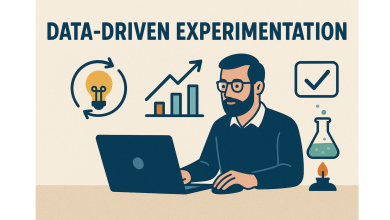For decades, executives could treat data as background noise.
Analysts built spreadsheets, IT teams managed the infrastructure, and consultants translated numbers into strategy. Leadership meant setting vision, negotiating deals, and driving culture.
But the age of artificial intelligence has rewritten that script. By 2026, the global AI analytics market will reach more than $50 billion.
Data has stepped out of the background and taken center stage and leaders who cannot read, interpret, and question data are already finding themselves sidelined.
What Data Literacy Really Means
Data literacy for executives is not about writing code or building models. It is about developing fluency. Leaders must know enough to interpret trends, question assumptions, and identify where human judgment should override machine predictions. Four skills stand out:
- Comfort with charts, probabilities, and distributions.
- The habit of asking sharp questions when the numbers don’t quite add up.
- The knack for turning raw figures into stories that energize teams and win over stakeholders.
- A grounded understanding of how AI models are built, along with a clear sense of where they fall short.
From Intuition to Information
Leadership used to lean more on instinct than on numbers. The gut feel of experienced executives carried real weight at a time when markets shifted slowly and data was harder to come by.
Intuition is still useful, but it now sits beside constant flows of real-time insight created by AI systems that sort through millions of data points in just seconds.
Look at Amazon. The way it manages inventory, serves up product recommendations, and keeps logistics humming all comes back to leaders who understand how data moves through the company.
Netflix tells a similar story. Decisions about which shows to fund or cancel are backed by predictive models of what audiences will watch next. In both cases, the top table is not occupied only by technologists. It is filled with decision-makers who are fluent in data, people who can weigh probabilities, challenge assumptions, and turn raw output into strategy.
Why Data Literacy is the New Currency of Leadership
Why does data literacy matter at the executive level? There are four main reasons.
- Decisions must keep pace with markets: AI systems run constantly, updating forecasts and flagging risks as they happen. Leaders who rely on second-hand reports slow the entire process down. Imagine a chief executive reviewing a live dashboard that shows churn climbing, then shifting budget toward retention that same day. Acting in the moment can be the difference between holding ground and losing it.
- Credibility depends on clear use of data: Boards, investors, and employees expect straightforward explanations. A PwC survey showed that most CEOs believe data-driven choices build stronger trust. When executives explain why an AI tool produced a recommendation, they show accountability. When they fall back on vague language, confidence weakens.
- Supervision of AI relies on knowledge-based judgment: Good supervision is required on how the outputs from AI systems are interpreted and implemented. Most AI tools available today are not 100% accurate. They may introduce bias, misuse sensitive information, or produce results that lack clarity. Executives with AI systems knowledge and data literacy can review flaws in such tools, uncover weaknesses, and show responsibility to regulators, customers, and employees.
- Data creates a real competitive edge: McKinsey research found that organizations guided by data are far more likely to gain customers and improve profits. The conclusion is straightforward. Treating data literacy as a side issue puts companies at risk, while treating it as essential gives them an edge in growth and resilience.
The Ethical Dimension
Competitive advantage is only part of the story. There is also a moral responsibility.
AI systems shape decisions in hiring, lending, law enforcement, and healthcare. When those systems make mistakes or reflect hidden bias, the consequences can damage lives and weaken public trust.
Leaders who recognize how bias enters a dataset are in a better position to reduce harm. They can call for openness from vendors, require regular bias checks, and make sure their companies honor values as well as financial goals.
A good reminder of this came with the Apple Card in 2019. Customers began pointing out that men and women were receiving very different credit limits. The company faced sharp criticism because the leadership team had not spotted the bias before it reached the public. If the executives had been more fluent in data, they might have raised the right questions earlier and avoided the reputational hit.
How Can Leaders Develop Data Literacy?
Here are the main ways leaders can build data literacy. The process usually combines structured learning, hands-on practice, and setting the right tone for the organization.
- Build foundational knowledge: Build foundational knowledge: Leaders don’t need to become data scientists themselves, but they should understand the basics of how analytics, probability, and machine learning shape business decisions. Many executives pursue short workshops or executive education programs for this purpose.
- Hire a team of experts: While leaders focus on strategic literacy, organizations still need deep technical expertise to unlock the full potential of AI and data. Supporting team members in pursuing advanced study like an online MS in Data Science and Analytics can help develop specialists who bring advanced knowledge in machine learning, governance, and predictive modeling. By pairing leadership’s data fluency with a skilled technical team, companies create a strong foundation for innovation and smarter decision-making.
- Engage directly with tools: Leaders should use dashboards and analytics platforms themselves instead of handing everything to others. By reviewing live metrics regularly, they learn how indicators shift and behave. Over time, they gain the ability to recognize unusual changes and pick up early signs of risk or opportunity.
- Encourage a culture of data fluency: The questions leaders ask shape the behavior of their teams. When they probe into metrics during discussions, they show that data is valued. This approach spreads across the company and helps build a culture where evidence matters more than hunches. Deloitte research shows that businesses with strong data cultures outperform peers in both revenue growth and innovation.
The Road Ahead
AI is reshaping what it means to lead. Future executives will not be judged only on vision or personal presence, but on how well they can read, interpret, and act on complex information. They will need to tell stories with evidence that motivates teams, protect ethical standards in how AI is used, and balance instinct with analysis when making hard choices.
Mary Barra, the CEO of General Motors, says data is central to the company’s shift to electric vehicles. For her, it is not only about making operations smoother but about guiding the company’s big decisions. Leaders like Barra show that modern leadership means having vision, being clear, and knowing how to use data.
Conclusion: A New Standard for Leadership
Data literacy has become part of the standard toolkit for leaders in the age of AI. It now stands beside financial skills and long-term vision as an essential competency.
Leaders who ignore data literacy put their companies in danger, trailing behind quicker competitors and facing damage to reputation or trouble with regulators. Whereas, executives who invest in it move faster, earn trust, and open the door to new opportunities.
The steps are straightforward. Learn the basics through education. Use data directly in daily decisions. Shape a culture where evidence matters more than guesswork. Provide oversight that keeps AI responsible and fair.
Executives who commit to this path will not be caught off guard by change. They will be the ones shaping it.




